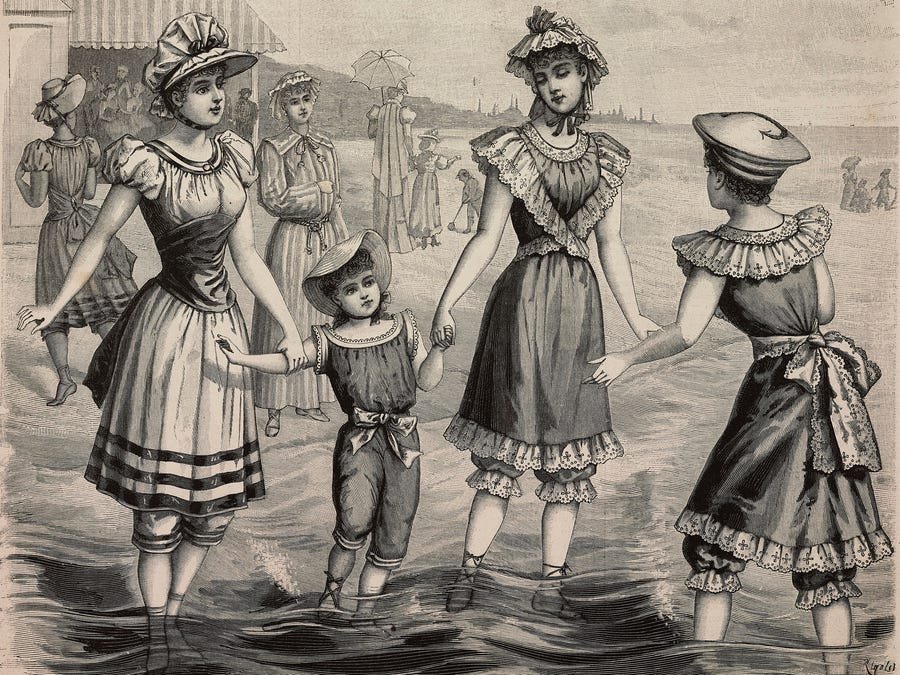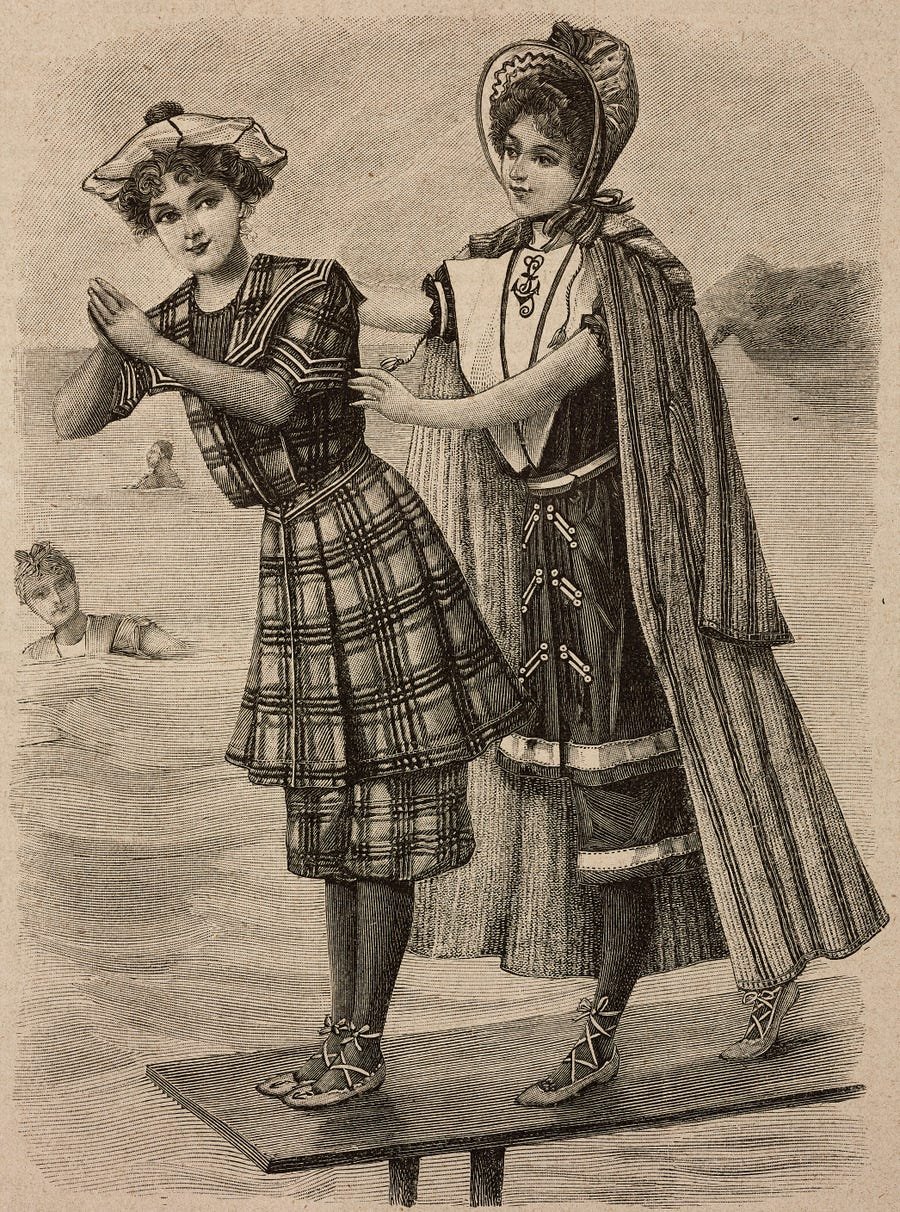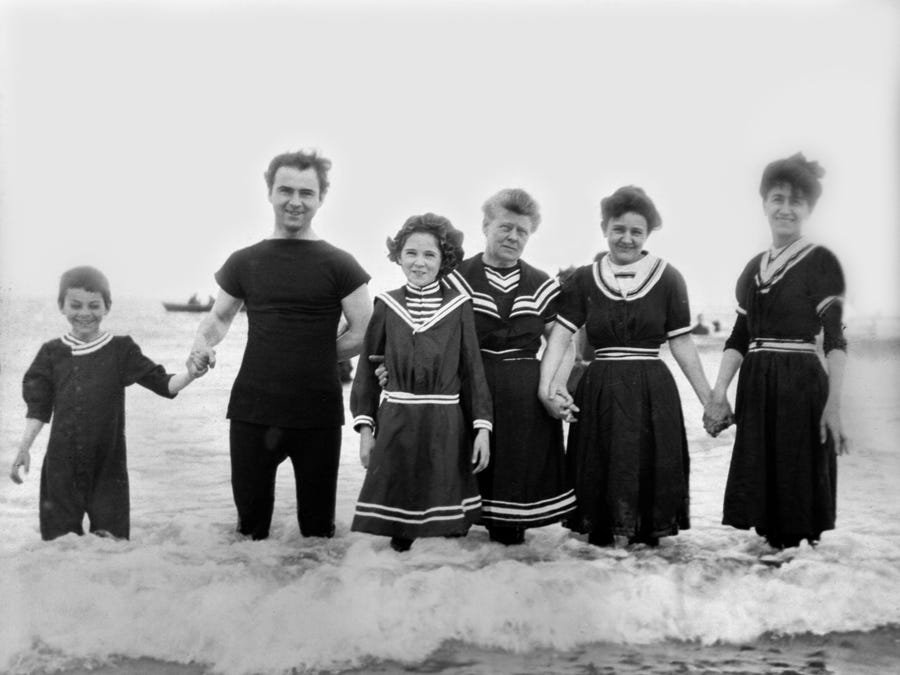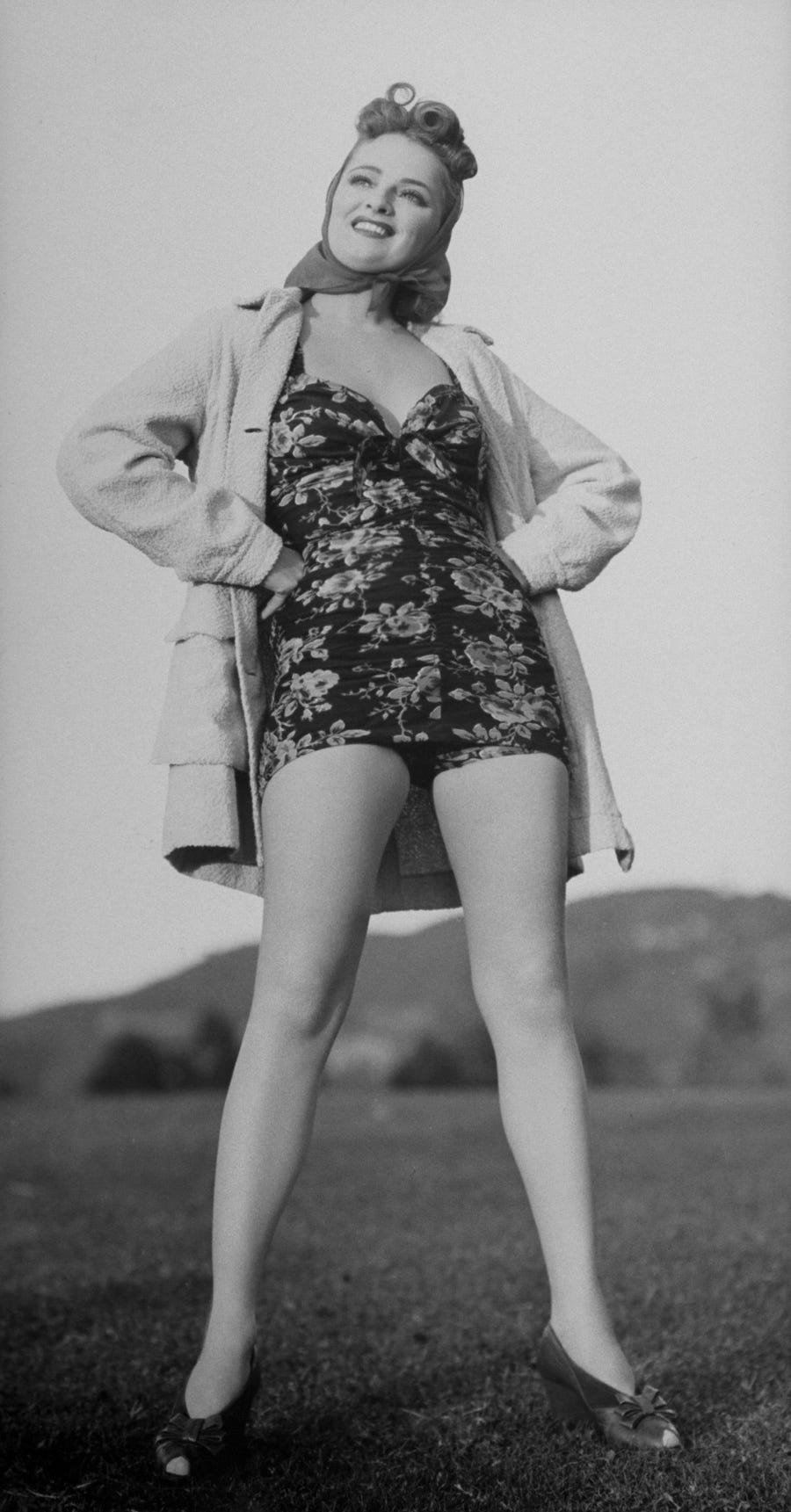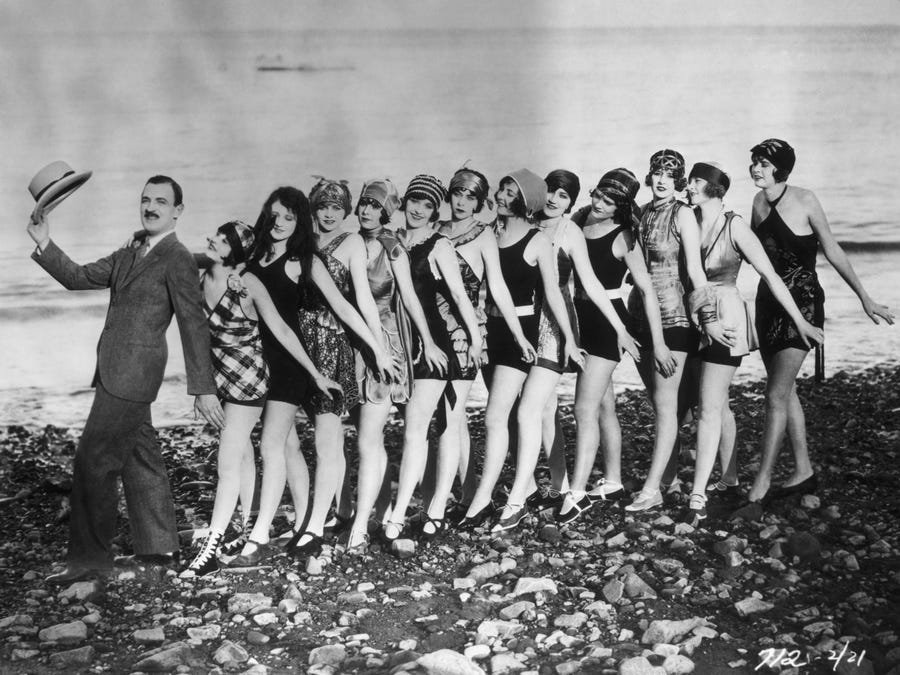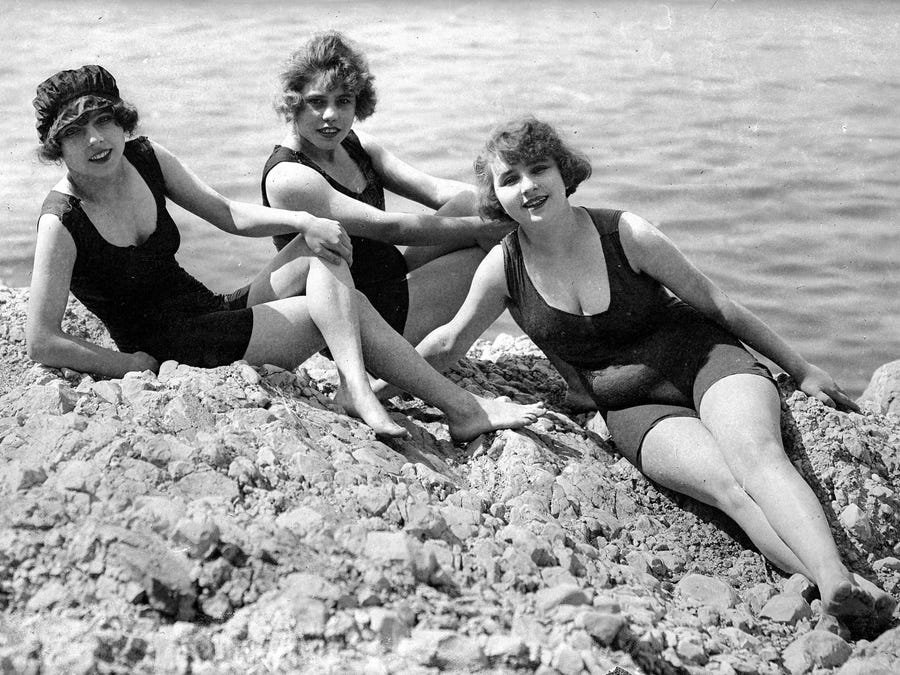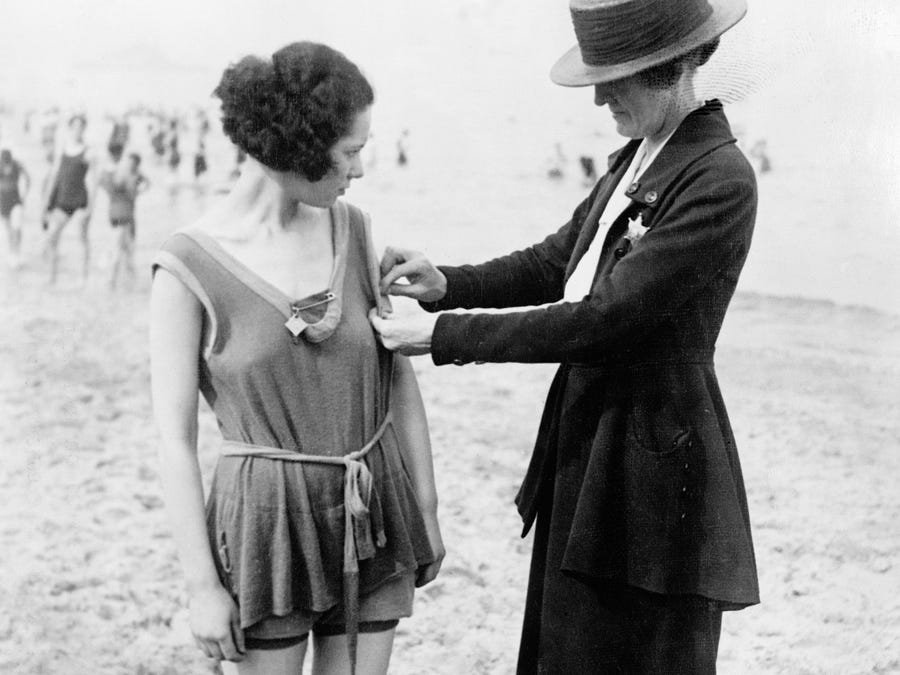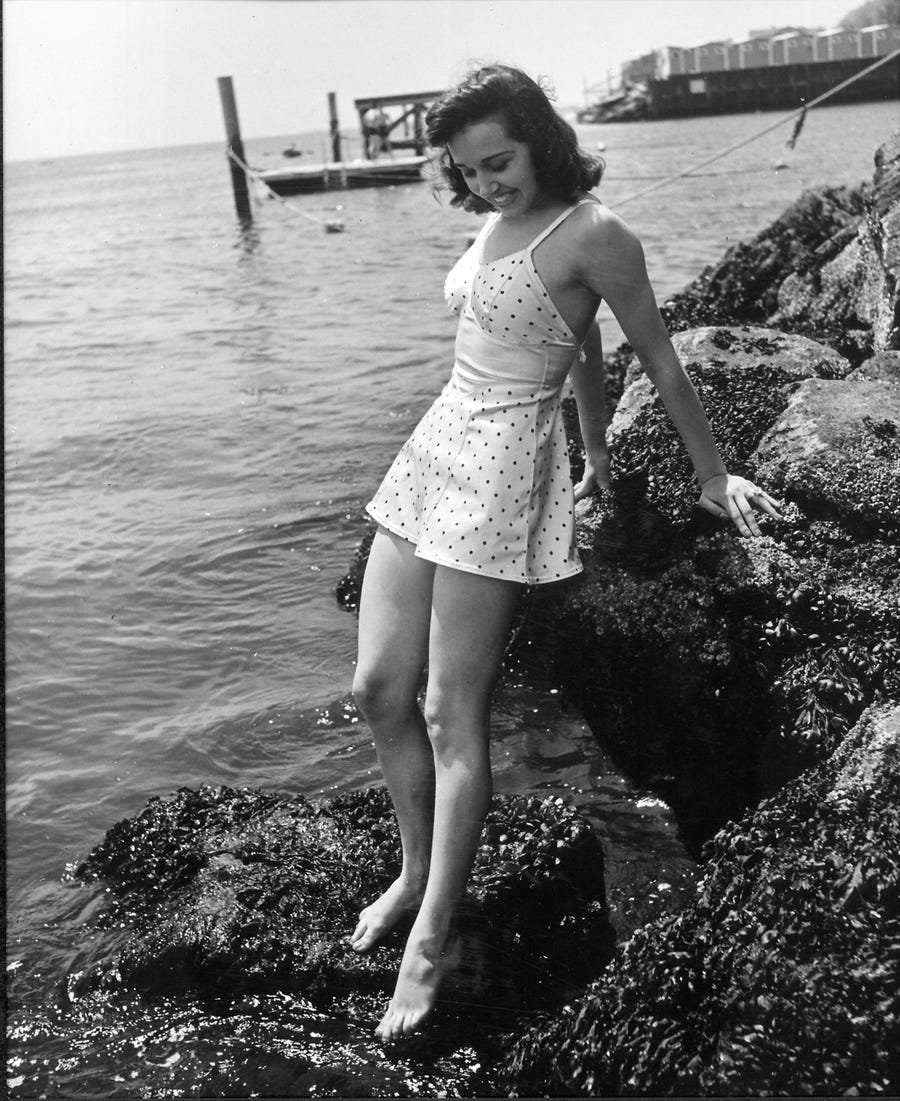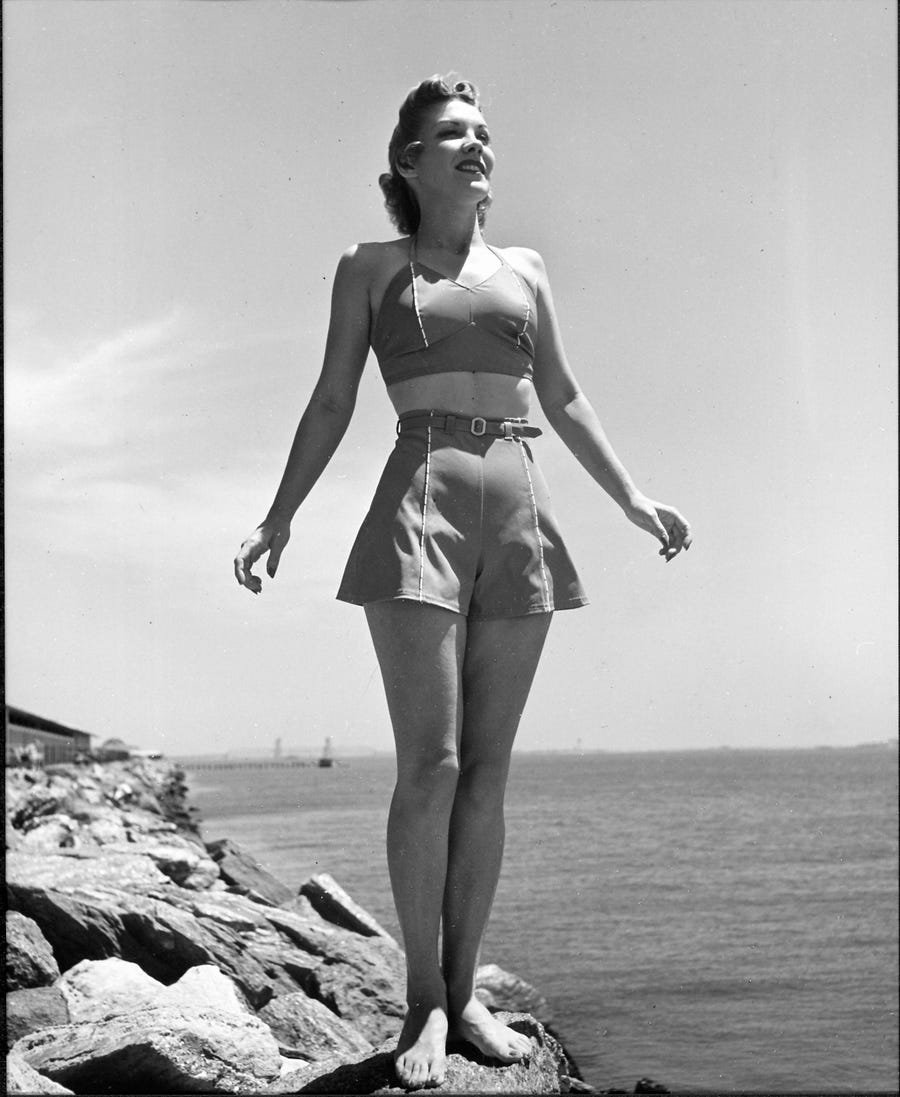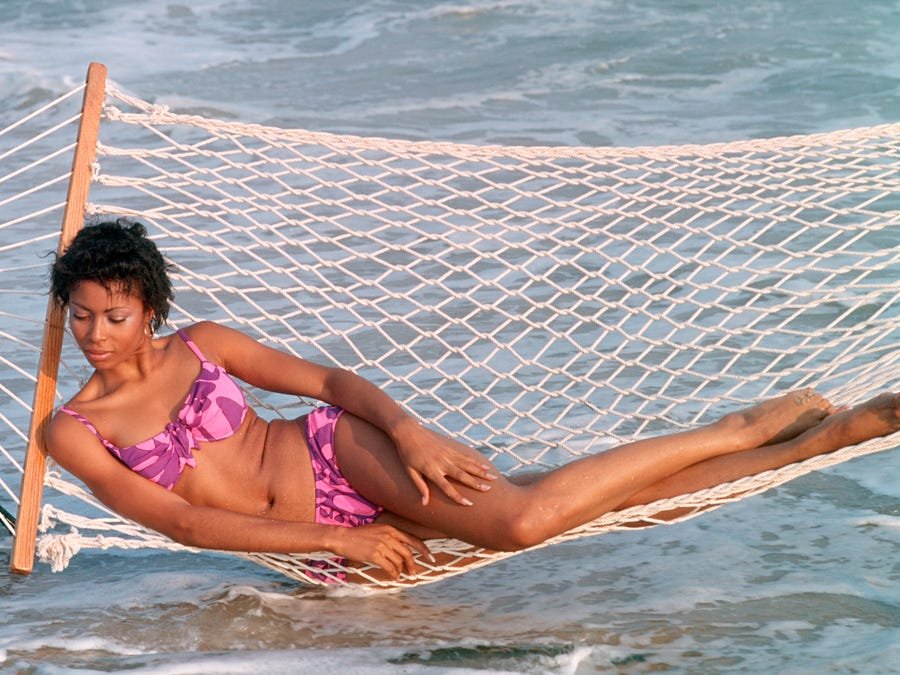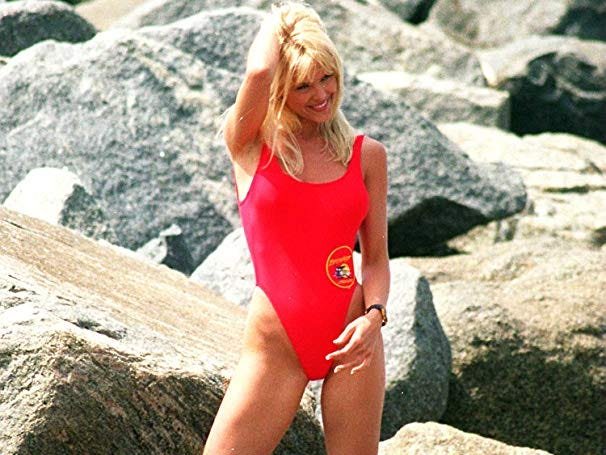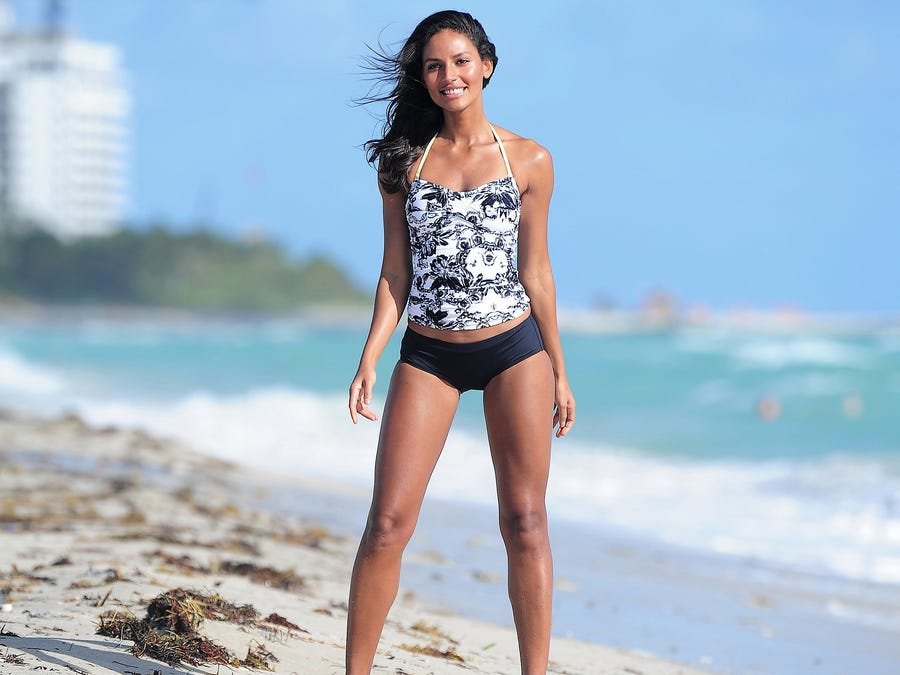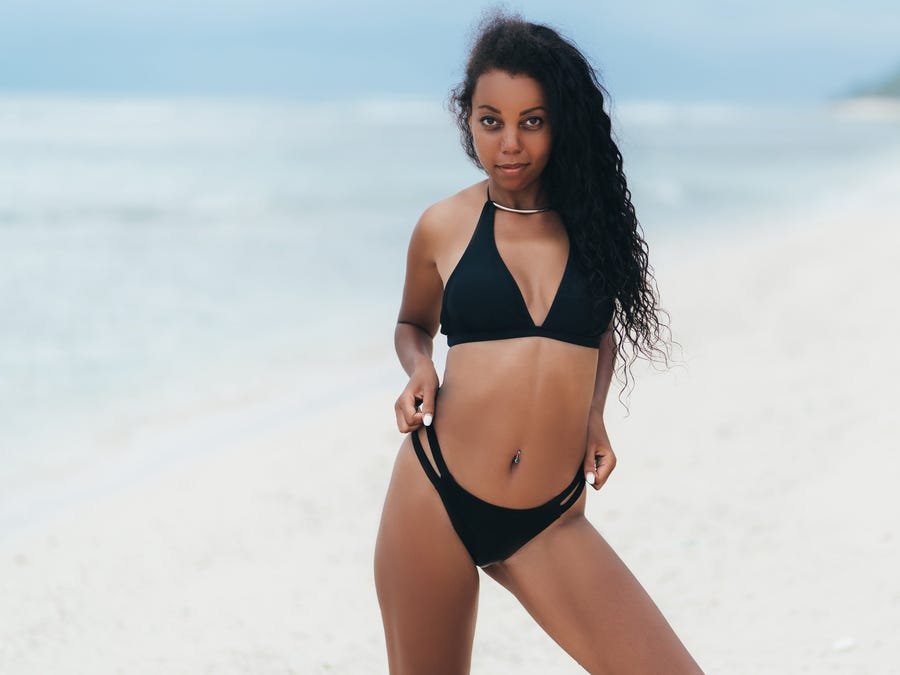From the 1800s to now: Here's how swimsuits have changed over the years
/Bathing gowns covered up quite a bit in the 1800s.
Bathing machines were meant to provide privacy and coverage for women who were changing into their swimsuits.
Hulton Archive/Getty
In the 1800s, swimsuits were typically called bathing gowns and they were long dresses that didn't show much skin. They were commonly made of wool.
Bathing gowns had long skirts and sometimes weights were sewn into the hems so the fabric wouldn't float up when it was submerged in water.
During this time, women also used bathing machines to keep things even more under wraps. These carriages were rolled into or near water and individuals (usually women) got inside of them to change into their swimsuits.
In the late 1800s and early 1900s, bathing shoes were also popular.
Bathing shoes helped to protect one's feet.
De Agostini / Icas94/Getty
In the 19th and early 20th century, some women didn't even let their feet go naked. Bathing suits were usually accessorized with bathing slippers, which were shoes that protected feet from broken glass and shells.
These slippers were commonly made of twisted straw or felt and they had laces. Sometimes women would make them look more stylish by adding ribbons, bows, or braids.
In the early 1900s, a woman's swimming look probably included bathing caps.
It wasn't unusual to wear a cape, hat, and shoes when heading to the lake.
DEA / ICAS94 / Contributor/Getty
During this time, it was also common for women to accessorize their bathing suits with small hats called bathing caps. They were oftentimes used to protect one's hairstyle.
Some women also wore fancy handkerchieves or scarves on top of their cap to make it a bit more stylish.
Sailor-inspired bathing suits became popular in the early 1900s.
New swimsuit designs began developing at this time.
Getty/Kirn Vintage Stock
Per Victoriana magazine, a popular swimsuit in the 1900s was made of black-and-white striped taffeta and featured a sailor-style collar, black silk stockings, and black leather sandals. Other popular bathing dresses of this time featured similar large collars.
Bathing coats were also popularly worn in the early 1900s.
It wasn't unusual to pair your swimsuit with a kerchief.
Mansell/The LIFE Picture Collection/Getty
As modesty was still quite important, women popularly covered up their bathing gowns with bathing coats. Sometimes these coats were made from silk and they typically had long sleeves and full capes.
Women usually wore this coat to the beach, took it off at the water's edge, then put it back on again as she got out of the water.
Around 1910, swimsuits became shorter and more form-fitting.
Swimsuits had short skirts.
Bettmann / Contributor/Getty
After years of piling on the clothing to go in the water, women traded bathing gowns for more form-fitting swimsuits that featured shorter skirts.
But around this time, women began being called out in public and punished for wearing swimsuits that law enforcers considered to be too revealing.
In 1907, record-breaking Australian swimmer Annette Kellerman was arrested on a beach in Boston, Massachusetts, and charged with indecent exposure because she'd been wearing a knee-length swimsuit that resembled a unitard and showed her arms, legs, and neck.
"Me, arrested!'' Kellerman said in a 1953 Boston Sunday Globe article recalling the 1907 incident, per Boston.com. "We were all terribly shocked, especially my father, for I was his innocent protected little girl. But the judge was quite nice and allowed me to wear the suit if I would wear a full-length cape to the water's edge.''
She is noted as being one of the first women to wear this style of one-piece swimsuit.
In the 1920s, swimsuits' necklines got lower.
Swim caps were still popular.
ND/Roger Viollet/Getty
As swimsuits became more practical, they also showed off more of a woman's body. Deep boat necks or V-necks became more popular and armholes on suits got bigger.
The colors of swimsuits also became brighter and the suits were sometimes accessorized with belts. Women still commonly wore swim caps and these special hats began to feature chin straps to help them stay in place.
Women continued to have swimsuit regulations enforced on them in the '20s.
An officer checking to see if this woman has violated any bathing-suit-related regulations.
Bettmann/Getty
Throughout this decade, women had to be careful to make sure their suits weren't too short or too revealing since beaches had certain swimsuit regulations designed with modesty in mind.
In some parts of the US, including places like Atlantic City, New York City, and Chicago, special deputies or regular police officers would patrol beaches, sometimes using measuring tape to measure certain parts of a woman's outfit, like the distance between her knee and her suit. If the officer felt the woman was showing too much bare skin, she could go to jail.
Many women, including noted novelist Louise Rosine protested these regulations. Per The Week, Rosine was arrested and jailed in Atlantic City in 1921 because she refused to wear the required stockings with her bathing suit.
Following the arrest, Rosine reportedly said: "The city has no right to tell me how I shall wear my stockings. It is none of their darn business. I will go to jail first."
The enforcement and protesting of these swimsuit regulations continued throughout the '30s and '40s.
Throughout the '20s and early '30s, men's swimsuits were simple and typically striped.
A child and his grandfather wearing similar suits.
Kirn Vintage Stock/Corbis via GettY
Throughout the '20s and early '30s, men's swimsuits consisted of a one-piece outfit that resembled a tank-top attached to shorts. The suits were commonly covered in thick, horizontal stripes and they came in colors like red and tan or blue and white.
Women's swimsuit necklines got lower and leg cuts got higher in the 1930s.
Women were still dealing with swimsuit regulations at this time.
Keystone-France/Gamma-Keystone via Getty
In the '30s, women's swimsuits started to resemble one-piece men's swimsuits. They were cut higher in the leg and showed more of the woman's back than they had in the past.
Swimsuits also began to feature thin straps, causing them to look more similar to the one-pieces that are popular today.
These suits also began to be made of lighter and more comfortable, rubber-based materials that were less stiff and more supportive than wool.
One-piece swimsuits started to look like little dresses in the 1940s.
The swimsuits sometimes had patterns.
Herbert Gehr/The LIFE Images Collection/Getty
A decade later, the one-piece changed again to resemble a short, tight dress with thin straps and a V-neck.
The top looked like a standard bra and the skirt covered a woman's backside, hips, and upper thighs. The halter top was also really popular during the '40s.
The ‘40s also featured the popularization of the bikini.
The bikini took off in the 1940s.
Herbert Gehr/The LIFE Images Collection/Getty
French designer Louis Reard created a daring two-piece swimsuit that would later be known as the first bikini in July 1946. It revealed a small amount of one's midriff and consisted of a halter top and shorts. Bandeau tops with halter straps also became more popular throughout this decade.
These slightly revealing styles became popular in the United States during World War II when wartime rationing inspired people to use less fabric when crafting clothing.
Throughout the '40s, swim briefs became popular for men.
Men's swim briefs were tight and small.
Kurt Hutton/Picture Post/Hulton Archive/Getty
They were typically high-waisted and were cut quite short. They'd initially been made of wool although a rayon-Spandex blend fabric was becoming more popular at this time.
During this decade, men's swim trunks, which were a bit longer and looser than the briefs, also began growing in popularity.
In the ‘50s, the material of bathing suits changed again.
Colorful swimsuits were popular.
Archive Photos/Getty
Although one-piece and two-piece suits still looked similar to the suits of the '40s, the material continued changing in the '50s. Nylon and elastic were used to make suits stretchier and to help them dry faster.
The '60s brought about more tight swimsuits.
Swimsuits were sold in a variety of patterns.
Three Lions/Getty
Bikinis got tighter and smaller in the '60s and even one-piece suits became more revealing. In the mid-'60s, low-cut swimsuit bottoms became more popular and the bikini continued to gain traction.
These suits were mostly made out of Lycra or Nylon, making them more fitted and tight.
In the 1970s, swimsuits were much more revealing than ever before.
Colorful swimsuits were trendy.
Archive Photos/Getty
By the '70s, swimwear continued to get more revealing and daring. Thongs, string bikinis, cut-out swimsuits, and even sheer suits became trendy.
In the '70s, swimsuits also had plenty of vibrant patterns, too.
Everyone wanted to wear colorful patterns.
H. Armstrong Roberts/ClassicStock/Getty
Throughout this decade, women's swimsuits were commonly covered in colorful patterns and so were men's swimsuits.
Men's swimsuits were typically worn at a length that's still popular today and sometimes they were accented with fashionable belts.
The 1980s featured bold, colorful, patterned suits.
Neon colors were popular.
hoto Media/ClassicStock/Getty
It's probably not surprising that the '80s were bold in terms of aesthetics. Bright neons and animal prints were quite trendy.
Suits often featured low, scooped necklines with higher leg cuts. Thong-style bathing suits also took hold.
The ‘90s featured colorful and funky swimsuits.
Low-coverage swimsuits were all the rage.
Douglas Peebles/Getty
Bathing suits didn't calm down in the '90s — if anything, they got even bolder. Advertisements from the '90s show swimsuits in super bright colors, fun patterns, and funky styles. Athletic-inspired, one-piece Speedos were pretty popular, too.
In the mid-90s, "Baywatch" inspired some trends.
The red swimsuit became iconic.
NBC
The wildly popular show "Baywatch" (1989-2001) inspired some bathing suit trends throughout the '90s. Many popular one-pieces throughout this decade featured high-cut legs and a low, tank-top neckline.
Tankinis were everywhere in the early 2000s.
Tankinis are still popular.
Alo Ceballos/Getty
The early 2000s featured many styles that were popular in the '90s. Notably, the tankini emerged. Anne Cole, a designer, is credited with inventing this style.
A tankini is essentially a more modest version of a bikini: the top resembles a tank top and the bottoms are standard bikini bottoms.
Today, popular swimsuit trends are very broad.
Bikinis are still popular.
Getty
In the last few years, swimsuit trends have included one-piece suits making a comeback and high-waisted suits gaining traction. In the 2010s, it seems like the most popular swimsuits range from vintage-inspired trends to slightly more revealing options.
In 2019, swimsuits designed for poolside posing — not for actually swimming in — are also popular, albeit widely criticized.
Throughout 2020, leather-looking swimwear and retro-style suits with unique cut-outs were also huge.
FOLLOW US: @SWIMWEEKCALENDAR


